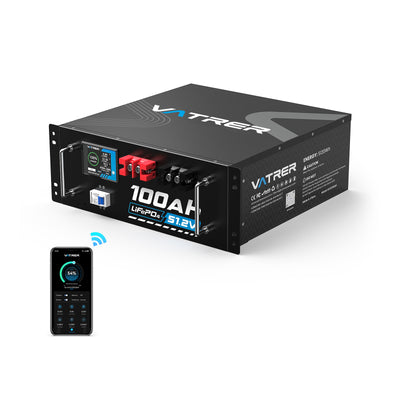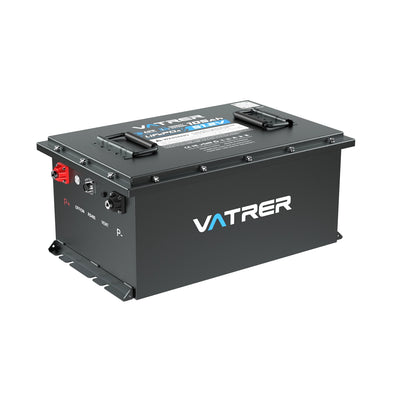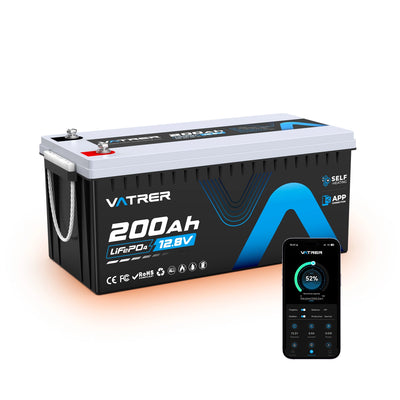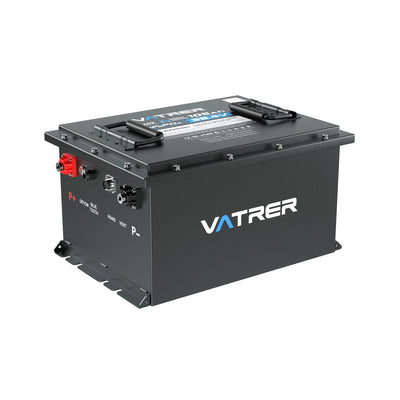
What Is The Best Deep Cycle Battery For a RV
Picture yourself on a remote campsite in the middle of nature, where your motorhome’s air conditioning can run through the entire night and the fridge stays cold around the clock, without any concern about running out of power. With a properly sized deep cycle RV battery, this level of independence becomes realistic, supplying consistent energy for your lighting, appliances and on-board electronics even when you are completely off the mains.
Deep cycle batteries are engineered to deliver a steady flow of power over many hours, which makes them indispensable for wild camping. As lithium deep cycle RV batteries become more common thanks to their high efficiency and long service life, this detailed guide will help you select the most suitable RV deep cycle battery for your style of travelling, so that comfort and reliability accompany you on every journey.

What Are Deep Cycle Batteries for RV Camping?
You can think of a deep cycle RV battery as a long-distance runner, providing a continuous supply of energy to your motorhome’s systems for many hours, rather than a starter battery that only delivers a brief surge of power.
These batteries are designed to tolerate deep discharges of roughly 80%–100% of their capacity without suffering damage. This makes them well suited to operating demanding equipment such as microwaves, CPAP machines or air conditioning units during prolonged stays away from electrical hook-ups.
Understanding the distinctions between different battery chemistries – including LiFePO4, AGM, gel, flooded lead-acid and combined deep cycle marine and RV batteries – allows you to choose a solution that fits your RV usage pattern and supplies dependable power for both weekend trips and extended touring.
If you would like to read more about deep cycle batteries, you can explore:
What is a group 24 deep cycle battery?
Exploring Types of Deep Cycle RV Batteries
To identify the best RV deep cycle battery for your needs, it is important to understand the advantages and limitations of each technology. The sections below compare the main options commonly used in RV camping.
Lithium Iron Phosphate (LiFePO4)
LiFePO4 deep cycle batteries are a favourite among many motorhome owners, acting as a dependable power source for everything from CPAP devices to induction hobs during off-grid stays. They support rapid charging (up to around five times faster than AGM), offer a much lower weight (typically 30–50% lighter than lead-acid) and can be discharged to their full capacity without harm. With a lifespan in the region of 2,000–5,000 cycles, they significantly outperform most traditional RV battery types. Their inherently stable chemistry improves safety in confined RV installations, and they are more environmentally friendly, containing no toxic heavy metals and complying with RoHS requirements.
Absorbed Glass Mat (AGM)
AGM deep cycle RV batteries are comparable to robust off-road vehicles: they are built to cope with vibration and harsh weather, including sub-zero temperatures. They are sealed, maintenance-free and non-spillable, and can normally be discharged to around 80% of their capacity, which suits shorter off-grid trips. However, their cycle life (around 500–1,000 cycles) is more limited than LiFePO4, and they must be charged carefully to avoid premature wear or damage caused by overcharging.
If you are considering AGM technology, you can find further details here: what is an AGM battery?
Gel Battery
Gel batteries use an electrolyte that has been turned into a gel, effectively sealing the contents and reducing the risk of leaks and gas emissions compared with conventional flooded lead-acid batteries. They are maintenance-free and offer reasonable charging efficiency, but they require a very specific, gentle charging regime to avoid internal damage. Because of these specialised charging requirements and limited product availability, they tend to be less convenient for most RV users than AGM or LiFePO4 batteries.
Flooded Lead-Acid
Flooded lead-acid batteries are the classic, low-cost option, but they come with considerable weight and higher maintenance demands. They are susceptible to overheating, need regular monthly checks and topping up of the electrolyte, and release hydrogen gas while charging, which must be safely ventilated. To prevent freezing they should be stored fully charged, and with a recommended discharge limit of around 50% and a typical service life of 300–500 cycles, they are not ideal for frequent deep-cycling in RV applications.
Marine and RV Batteries
Deep cycle marine and RV batteries, commonly supplied in group 24 deep cycle RV battery or group 27 sizes, are hybrid designs that combine starting and deep-cycle characteristics. They are relatively economical but not as robust as dedicated deep cycle batteries. They are suitable for RVs that frequently use campsite hook-ups, provided they offer adequate reserve capacity and a slow discharge rate to support the on-board equipment.
The table below outlines the main differences between the various RV battery types and can assist you in choosing a solution that matches your electrical requirements and camping habits.
| Battery Type | Service Life (Cycles) | Maintenance Needs | Permitted Depth of Discharge | Typical Weight | Most Suitable For |
|---|---|---|---|---|---|
| LiFePO4 | 2,000-5,000 | None | 100% | Light | Wild camping, long-term touring |
| AGM | 500-1,000 | None | 80% | Moderate | Short breaks, rough roads |
| Gel | 500-800 | None | 50-80% | Moderate | Stable conditions, controlled charging |
| Flooded Lead-Acid | 300-500 | High | 50% | Heavy | Tight budgets, campsite hook-ups |
Why LiFePO4 Deep Cycle Batteries Are Ideal for RV Camping
The low weight of lithium batteries helps to improve fuel consumption and makes installation and handling easier in an RV. Integrated Battery Management Systems (BMS) provide protection against overcharging, excessive temperatures and short circuits, which is especially important in confined motorhome compartments. LiFePO4 batteries are also more environmentally responsible, avoiding hazardous waste and supporting a more sustainable approach to camping – something that appeals to many environmentally aware travellers.
Although the purchase price is higher at the outset, the investment pays off over time. Their typical service life of around 5–10 years greatly reduces how often they need to be replaced. For this reason, lithium deep cycle RV batteries are often the most sensible choice for those who want dependable power during dry camping and off-grid trips.
How to Choose the Best Deep Cycle Battery for Your RV
Choosing the best RV deep cycle battery involves balancing your electrical demand with practical considerations. The following points are particularly important:
- Capacity (Amp-Hours, Ah): Capacity, expressed in amp-hours (Ah), determines how long your battery can run your equipment. A 12 volt deep cycle RV battery in the 100–200 Ah range is suitable for regular off-grid use, whereas a group 24 deep cycle RV battery (around 70–85 Ah) is sufficient for lighter, occasional use.
- Depth of Discharge (DoD): LiFePO4 batteries can typically be discharged down to 100% of their rated capacity, while lead-acid technologies such as AGM deep cycle RV batteries should usually be limited to about 50% discharge to extend their lifespan.
- Voltage: Most RV installations are based on 12V RV battery deep cycle systems, although some owners connect pairs of 6 volt deep cycle RV batteries in series to form a robust 12V system.
- Charging Compatibility: Check that the battery will work with your solar panels, inverter, generator or mains hook-up. LiFePO4 batteries are particularly effective with fast charging from solar arrays or alternators.
- Temperature Tolerance: Batteries need to cope with temperature variations and moisture. LiFePO4 and AGM units perform well in this respect, and several LiFePO4 models include low-temperature protection. Batteries such as the Vatrer RV battery, which combines low-temperature cut-off, Bluetooth connectivity and self-heating, are designed to support your camping lifestyle in a wide range of climates.
- Vibration Resistance: Travelling in an RV exposes batteries to shocks and vibrations. AGM and LiFePO4 batteries handle these conditions well. All Vatrer batteries meet IP65 protection standards.
- Size and Weight: Compact, lightweight batteries such as LiFePO4 save valuable storage space and reduce the overall load on your vehicle.
- Warranty and Support: LiFePO4 batteries often come with guarantees of 5–10 years, whereas AGM or flooded lead-acid batteries typically offer around 1–3 years. This reflects their longer lifetime. Select manufacturers with solid after-sales support, such as Vatrer battery.
Cost-Benefit Analysis: LiFePO4 vs. Other RV Deep Cycle Batteries
A 100Ah lithium deep cycle RV battery will typically cost between $600 and $1,200, while an equivalent AGM deep cycle RV battery may range from about $25 to $450, and a flooded lead-acid alternative roughly $100 to $300.
Although LiFePO4 requires a higher initial outlay, its lifetime of more than 5,000 cycles equates to approximately $0.20 per cycle. By comparison, an AGM battery with around 800 cycles comes to about $0.38 per cycle, and a lead-acid battery with roughly 500 cycles to about $0.60 per cycle.
Flooded lead-acid batteries may also require dedicated ventilation when installed in an RV, which can increase total system costs. For people who use their motorhomes frequently, the maintenance-free design and long life of LiFePO4 batteries often result in substantial savings over time.
Top Best Deep Cycle Battery Recommendations for RVs
Selecting the right deep cycle RV battery will ensure that all your on-board systems – from lighting to air conditioning – operate reliably while you travel.
Vatrer lithium deep cycle RV batteries provide stable, long-lasting power and incorporate advanced functions such as Bluetooth monitoring and self-heating to support different RV camping scenarios.
Below are five recommended Vatrer models tailored to motorhome use, designed to match a variety of layouts and camping preferences.
Before ordering, check the dimensions of your RV’s battery compartment and the existing wiring to ensure a proper fit, particularly if you are considering group 24 deep cycle RV batteries.
- Vatrer 12V 100Ah Group 24 Battery: Well suited to compact motorhomes or weekend trips, this 12V RV deep cycle battery provides 1,280Wh of energy and weighs only 23.14 lbs. The integrated 100A BMS ensures safe operation for modest loads such as LED lighting, ventilation fans or a 12V refrigerator. It is an excellent option for Class B motorhomes or van conversions where space is limited.
- Vatrer 12V 100Ah LiFePO4 Heated Battery: Developed for cold-weather wild camping, this LiFePO4 deep cycle battery includes a low-temperature cut-off that stops charging below 32°F (0°C) to protect the cells. With 1,280Wh of capacity and a 100A BMS, it can power key devices such as CPAP units or small heaters. Bluetooth connectivity allows you to monitor performance via the Vatrer app. Weighing 24.20 lbs, it is an attractive solution for RVers who often travel in colder regions.
- Vatrer 12V 200Ah Plus Lithium Battery: This versatile deep cycle RV battery, offering 2,560Wh of energy and a 200A BMS, is a strong choice for medium-sized motorhomes. It is capable of supporting higher-demand appliances such as microwaves or air conditioning units. With low-temperature cut-off and a weight of 48.5 lbs, it is suitable for Class C RVs or for users who frequently camp off-grid and require reliable power for longer stays.
- Vatrer 12V 460Ah Deep Cycle Lithium RV Battery: Designed for high power demand, this lithium deep cycle RV battery supplies 5,888Wh and includes a 250A BMS, making it suitable for large Class A motorhomes or fifth-wheel caravans running several appliances at once. Bluetooth monitoring provides real-time feedback, and the 3,200W power output comfortably supports loads such as induction hobs. At 104.7 lbs, it replaces several lead-acid batteries with a single, space-efficient unit.
- Vatrer 12V 560Ah Self-Heating Lithium RV Battery: A premium solution for comfortable, long-term RV travel, this deep cycle RV battery delivers 7,168Wh and uses a 300A BMS to support extensive off-grid systems with multiple air conditioners, fridges and other appliances. The self-heating function and Bluetooth connectivity maintain performance even in harsh climates, while its 5,000+ cycle life is ideal for full-time RV living. Weighing 136.58 lbs, it is designed for larger battery compartments in high-spec motorhomes.
These Vatrer LiFePO4 deep cycle batteries support a wide range of RV camping styles – from occasional weekend trips to full-time off-grid living. Their low weight, rapid charging capability and IP65-rated robustness make them highly suitable for dry camping, providing dependable power wherever your travels take you.
How BMS Enhances LiFePO4 Deep Cycle Batteries for RVs
The Battery Management System (BMS) functions as an electronic safety supervisor for LiFePO4 deep cycle batteries, continuously checking voltage, current and temperature to avoid overcharging, overheating or short circuits.
This continuous monitoring helps ensure safe and consistent operation in an RV, reducing the risk of sudden power failures that could interrupt your appliances during remote stays.
Many LiFePO4 batteries, including leading models from Vatrer, are equipped with Bluetooth-enabled BMS units, enabling real-time monitoring via smartphone applications. This allows RV owners to keep an eye on battery status while travelling, improving convenience and helping to optimise performance on longer journeys.
Solar and Inverter Compatibility for RV Deep Cycle Batteries
Many motorhome users rely on solar panels to recharge their batteries when off-grid, and LiFePO4 deep cycle batteries are particularly well matched to solar systems because of their fast charging characteristics.
A solar array in the range of 200–400W can usually charge a 100Ah LiFePO4 battery in about 4–8 hours under strong sunlight. For best results, use an MPPT (Maximum Power Point Tracking) solar charge controller, as simpler PWM regulators often deliver lower performance with LiFePO4 batteries.
These batteries also support higher discharge rates for inverters, enabling you to run 230V AC appliances such as air conditioners efficiently. Always verify that your inverter and charge controller are suitable for LiFePO4 to get the best performance and battery life.
Maintenance Tips for Your Deep Cycle RV Battery's Longevity
Correct maintenance practices can significantly extend the life of your deep cycle RV battery:
- LiFePO4: Effectively maintenance-free. Store fully charged at moderate temperatures and use the BMS or dedicated app to monitor status regularly.
- AGM/Gel: Also maintenance-free in normal use. Avoid overcharging and keep them in a cool, dry environment when the RV is not in use.
- Flooded Lead-Acid: Inspect electrolyte levels monthly, top up with distilled water where necessary and remove corrosion using a baking soda solution. For safety, always disconnect the negative terminal first. Undercharging promotes sulphation, where sulphate crystals form on the plates, reducing capacity and shortening the battery’s life.
Tips: Flooded lead-acid batteries should be recharged back to 100% after reaching around 50% depth of discharge to minimise sulphation. For deep-cycle lithium battery systems, use a digital voltmeter or a dedicated battery monitor to keep track of the state of charge in real time.
Conclusion
For the majority of motorhome owners, a LiFePO4 deep cycle battery is the most attractive option thanks to its long service life, high level of safety and low weight, all of which make it particularly suitable for dry camping and off-grid adventures.
AGM deep cycle RV batteries remain a reasonable solution for those with tighter budgets or who mainly stay on campsites with hook-ups, whereas flooded lead-acid batteries are generally less convenient because of their maintenance requirements.
Consider how often you travel, how you use your RV and how much power you typically need, then select a battery system that will genuinely improve your overall camping experience.
Unsure how to calculate your requirements? Vatrer's online calculator can assist you in designing a tailored power solution for your RV.
Share



















































